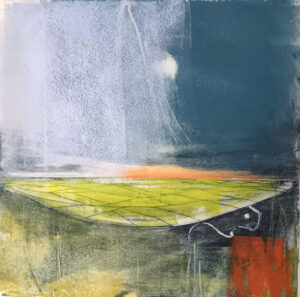A new film about Eric Ravilious shows his joy, and his wife’s despair, during wartime.
I was lucky enough to go to a viewing of ‘Eric Ravilious: Drawn To War’, a new documentary directed by Margy Kinmouth and released in cinemas in July. It features contributions from Ai Weiwei, Alan Bennett, Grayson Perry and Robert McFarlane.
I really enjoyed the film, not least because it’s about an artist I have had, if not a life long, then a long term, interest in. Ravilious came of age as an artist alongside Paul Nash, Edward Bawden and Barnett Friedman. Though, perhaps because of his early death in a plane crash in Iceland during the Second World War, he was largely ignored during most of the 20th century. His work is now enjoying a renaissance.
I can’t remember when I first became across Ravilious’ work, quite likely during my Illustration degree in the late 90’s. I do vividly remember the first time I saw his watercolours ‘in the flesh’ though. It was at the Imperial War Museum in London, where they were exhibiting both his work and his friend Edward Bawden’s exquisite portraits from the war in the Middle East.
I remember sitting in the gallery with a quiet smile filling my heart. Ravilious had somehow managed to convey the sheer joy of form, shape, colour, air and light of landscape, aeroplanes and flying, through his sheets of watercolour paper and dry brush strokes. I remember feeling little rushes of quiet joy as I looked at the little squares of light hung on the walls.
I felt the same 20 years later when I visited an exhibition of his work at the Arc in Winchester (and the excellent retrospective at Dulwich Picture Gallery several years ago). The feeling never fails to surprise me. I believe it partly comes from having the pictures altogether in one room and being able to step back and realise that, in real life, these paintings emanate light. Perhaps because they are made of that of that medium of light, watercolour, but also because Ravilious was a master of that medium.
There are a few things about ‘Drawn to War’ that struck me though. One was Ravilious’ ability to work in so many different mediums and ‘art businesses’- fine art, wood engraving, mural painting, illustration, design, books, lithography editions and teaching and to see no problem in this. A lot of this work was, by necessity, made to make enough money to get by, but he was also of a generation of British artists who had no snobbery in combining commercial and fine art in their careers. It also gives me hope as an artist, that this array of ‘income streams’, as they’d be called today, can exist side by side- and with no social media, internet or followers.
Secondly, I was surprised to suddenly understand how much Ravilious’ landscapes had permeated my own mind and work. The chalk paths leading up to the high places, the barbed wire and fencing, used as both compositional device and a way to bring the manmade and sightly sinister into a picture, ancient marks and figures on the landscape, the yearning to be there and not here- all these have found their way into my work in recent years.

Ravilious’ work is truly of the English topography, it has run through the Arcadia of Samuel Palmer, the light and dark of Blake’s wood engravings and come out the other side with the added pathos and beauty of the 20th century at war.
And yes, I do believe there can be beauty during war. Ravilious certainly seemed to find it wherever he went, in fact the film shows his apparent excitement at some of the subjects he was posted to paint. Which brings me to the other point that jumped out at me from ‘Drawn to War’: how long and miserable a war Ravilious’ wife, Tirzah Garwood, had. Tirzah was a talented artist in her own right, and I think the point is purposely made by Margy Kinmouth.
Tirzah spent the war stuck in a cold, crumbling farmhouse, looking after two young children, diagnosed with breast cancer, then undergoing and recovering from a mastectomy, all on her own. All the while receiving letters from Eric, rather gleefully describing his interesting times. She had already endured at least two affairs during their marriage. (Ravilious’ nickname was ‘The Boy’ due to his boyish attitude to most things).
While I don’t generally conflate an artist’s work with their personal life or flaws, as a woman and feminist, it struck me, not for the first time in my life, that it’s unlikely Ravilious would have been able to successfully fulfil all the artistic threads that he pursued, without the support and sacrifice of his equally artistic and capable wife. And while we revel in his joy of form and colour, there was an undercurrent of slog and sacrifice, poverty and misery that is not evident in his work. Much of this was the general relentlessness of trying to make a living as an artist, especially one from a working class background, but I do think the director is making the point that Tirzah took the lion’s share of the sacrifice.
There is much to unpick here, and I will save more for another post on this subject. The film is well worth a watch if you can catch it, if for no other reason that to indulge the eye with Ravilious’ work, though there is much more to enjoy here too. For more info and cinemas screenings click here.